Physical Address
304 North Cardinal St.
Dorchester Center, MA 02124
Physical Address
304 North Cardinal St.
Dorchester Center, MA 02124
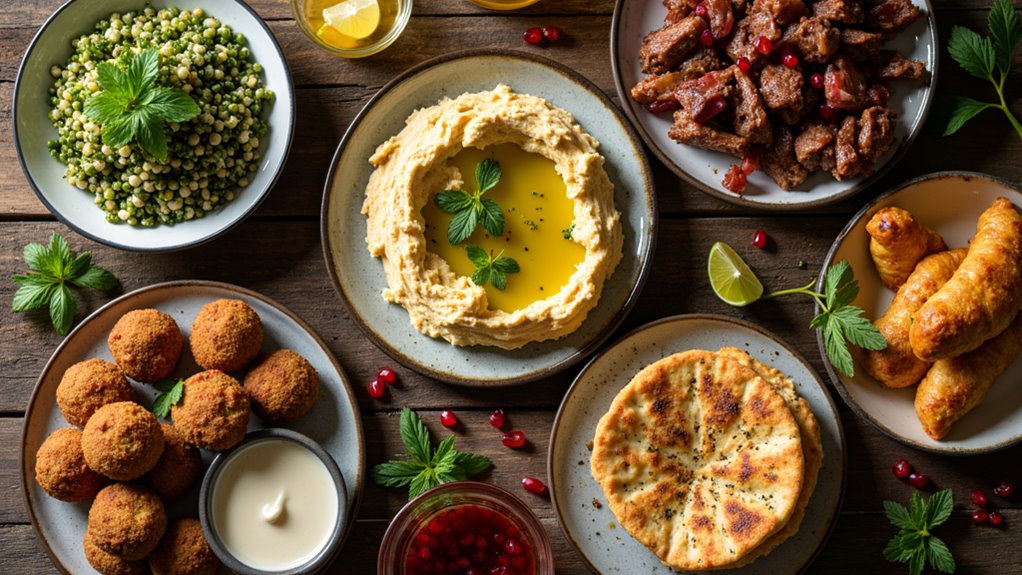
Lebanese flavors dazzle with communal mezze traditions and aromatic delights, but the secret to authentic dining experience lies...
Lebanese cuisine celebrates community through shareable mezze platters featuring hummus, tabbouleh, and kibbeh (the national dish). You’ll discover the morning ritual of manakish flatbread, street-food excellence of shawarma, and sweet pleasure of baklawa with orange blossom syrup. Don’t miss traditional drinks like arak, the anise-flavored spirit that turns milky when mixed with water. Each bite and sip offers a window into Lebanon’s opulent culinary heritage and social dining traditions.
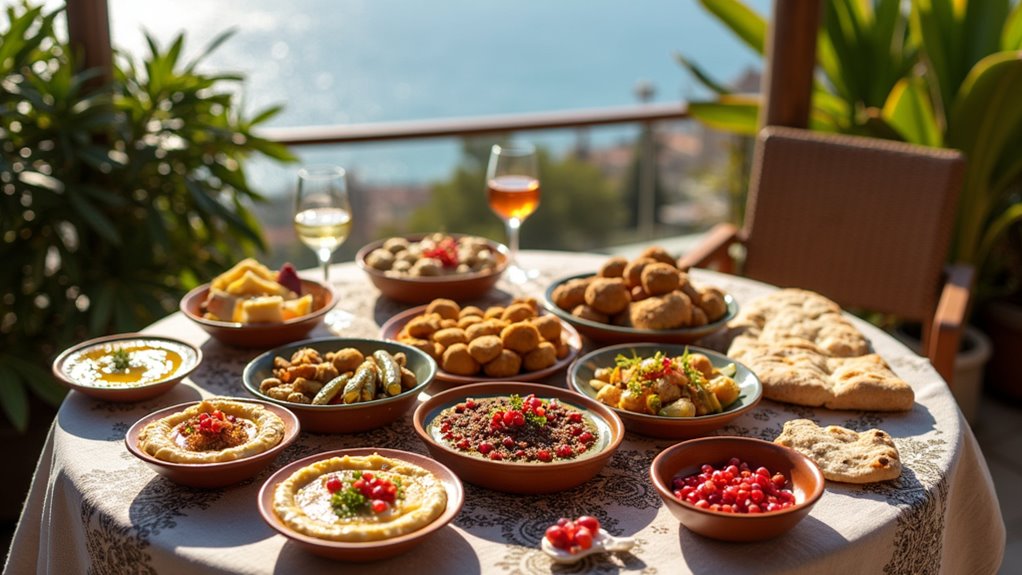
The mezze experience stands at the heart of Lebanese dining culture, offering a vibrant tapestry of flavors that exemplifies the country’s approach to food and hospitality. You’ll find tables transformed into colorful landscapes of small plates meant for sharing, from creamy hummus and smoky baba ganoush to tangy labneh and spicy muhammara.
Unlike appetizers, mezze can be the main event itself, with dozens of dishes creating a spectacular feast. When you’re invited to a Lebanese table, you’ll immediately notice the emphasis on abundance and variety. Stuffed grape leaves, pickled vegetables, warm pita, and marinated olives crowd together in an invitation to slow down, converse, and enjoy. In authentic Lebanese style, these ingredients are artfully arranged to create an overlapping small plates presentation that fills the entire table.
It’s not just about eating—it’s about connecting through food in true Lebanese tradition. Lebanese food culture is deeply rooted in the mezze experience, where sharing and socializing are just as important as the flavors themselves.
Five thousand years of culinary tradition stand behind kibbeh, Lebanon’s undisputed national treasure and perhaps its most celebrated contribution to world cuisine. You’ll find this ancient dish in countless variations across the country, from the raw kibbeh nayeh to fried croquettes and baked kibbeh bil sanieh.
At its core, kibbeh combines finely ground meat (usually lamb or beef), bulgur wheat, and a precise blend of spices including allspice, cinnamon, and mint. The preparation is often a family affair, with techniques passed down through generations to achieve that perfect texture. The authentic preparation traditionally employs methods like mortar and pestle to achieve the ideal consistency. When you’re invited to share kibbeh in a Lebanese home, you’re experiencing not just a meal but a symbol of hospitality deeply woven into the cultural fabric. While the Maldives and Seychelles are both renowned tropical paradises, Lebanon’s kibbeh is a cherished culinary tradition that showcases the country’s rich cultural heritage.
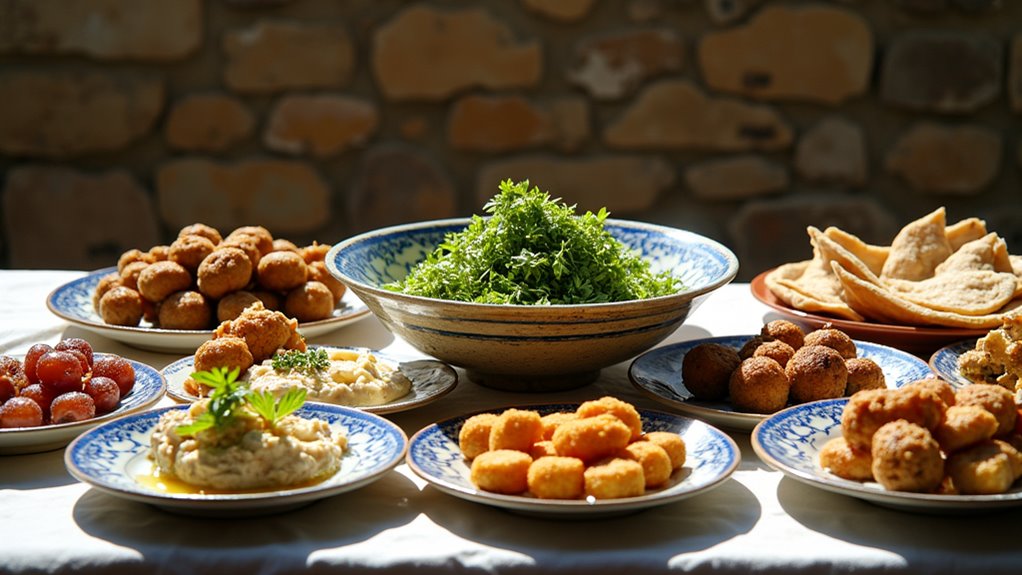
Celebrated across Lebanon and beyond, tabbouleh stands as a quintessential example of the country’s commitment to fresh, vibrant flavors. This iconic salad showcases finely chopped parsley and mint as its stars, complemented by juicy tomatoes, green onions, and a light sprinkle of fine bulgur.
You’ll find tabbouleh’s herbaceous profile balanced perfectly with tangy lemon juice and quality olive oil. Many Lebanese cooks prefer using extra fine bulgur that requires no cooking, only a brief soak to tenderize. While preparing it, Lebanese cooks meticulously chop the parsley to achieve that signature fine texture. The minimal bulgur serves merely as a supporting ingredient, not the base. Egyptian cuisine also features a variety of fresh and vibrant salads, such as the popular fattoush salad.
When you’re enjoying authentic tabbouleh in Lebanon, you’ll notice it’s served as part of the mezze spread, where its invigorating qualities provide the perfect counterpoint to more indulgent dishes. It’s Lebanese cuisine in its purest form—simple, nutritious, and bursting with flavor.
While tabbouleh brings herbaceous freshness to the Lebanese table, hummus stands as the creamy cornerstone of the country’s culinary identity. You’ll find this iconic chickpea dip at virtually every Lebanese gathering, where it’s traditionally served as part of mezze platters alongside warm pita bread.
The secret to authentic Lebanese hummus lies in technique—peeling chickpeas for ultimate smoothness and adding ice cubes while blending creates that silky texture you’ll crave. Lebanese families often prepare this dish using recipes passed down through generations, with many considering their family recipe the very best. The balance of tahini’s nuttiness with lemon’s brightness elevates this simple dish to an art form. Essential Arabic phrases can provide useful context for understanding the cultural significance of hummus in Lebanese cuisine.
Don’t miss the classic presentation: a swirl of olive oil, a sprinkle of paprika, and fresh parsley on top. It’s not just delicious but nutritious too, packed with protein, fiber, and heart-healthy ingredients.
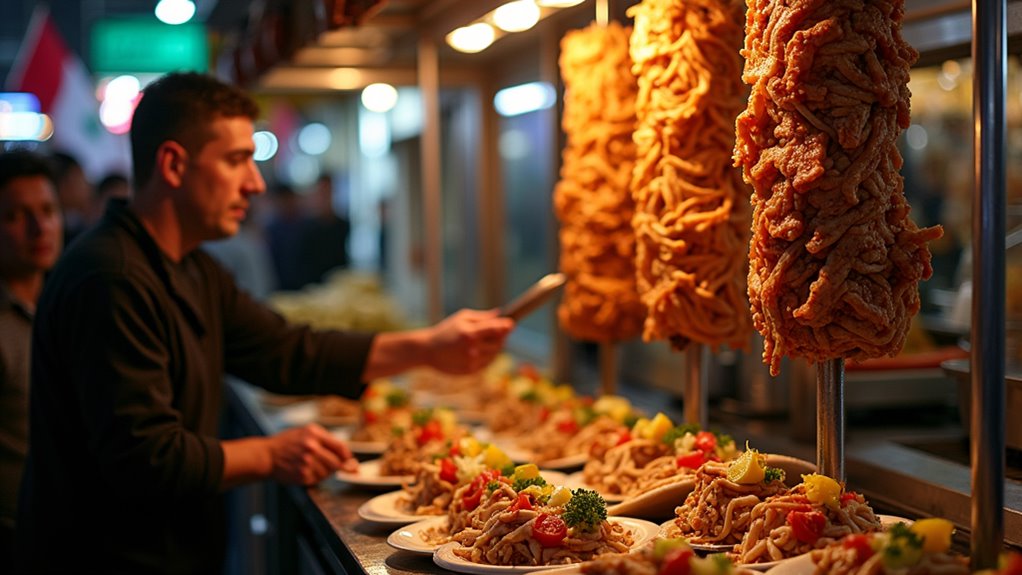
The magic happens as thinly sliced layers of marinated meat—typically lamb, chicken, or beef—slowly rotate and self-baste for hours.
As the outer edges crisp, vendors skillfully shave off tender pieces, wrapping them in warm pita with tahini, toum (garlic sauce), pickles, and fresh vegetables. Egypt is a popular honeymoon destination, and the vibrant Lebanese food culture is another reason for travelers to visit the region.
You’ll find regional variations throughout Lebanon, including vegetarian options featuring roasted cauliflower. This beloved dish derives from the Ottoman Turkish term çevirme, meaning “turning” or rotisserie, perfectly describing its preparation method.
Don’t miss this portable masterpiece that reflects centuries of cultural exchange and represents the accessible, communal spirit of Lebanese cuisine.
Known across Lebanon as the quintessential morning meal, manakish combines the comfort of freshly baked flatbread with aromatic toppings that’ll awaken your senses at first bite.
This “Lebanese pizza” dates back to the 10th century and earned UNESCO recognition in 2024. Port Louis, the capital city of Mauritius, is also known for its vibrant culture and cuisine. You’ll find it traditionally topped with za’atar (a zesty blend of thyme, sumac, and sesame seeds), creamy cheese varieties like akkawi or halloumi, or savory minced meat.
When you’re in Lebanon, head to a local bakery early morning to watch bakers press finger indentations into the dough before sliding it into wood-fired ovens.
Enjoy your manakish hot, folded or sliced, alongside labneh or olives for an authentic Lebanese breakfast experience. Often called the poor man’s food in Lebanon, manakish remains beloved for its affordability without sacrificing flavor.
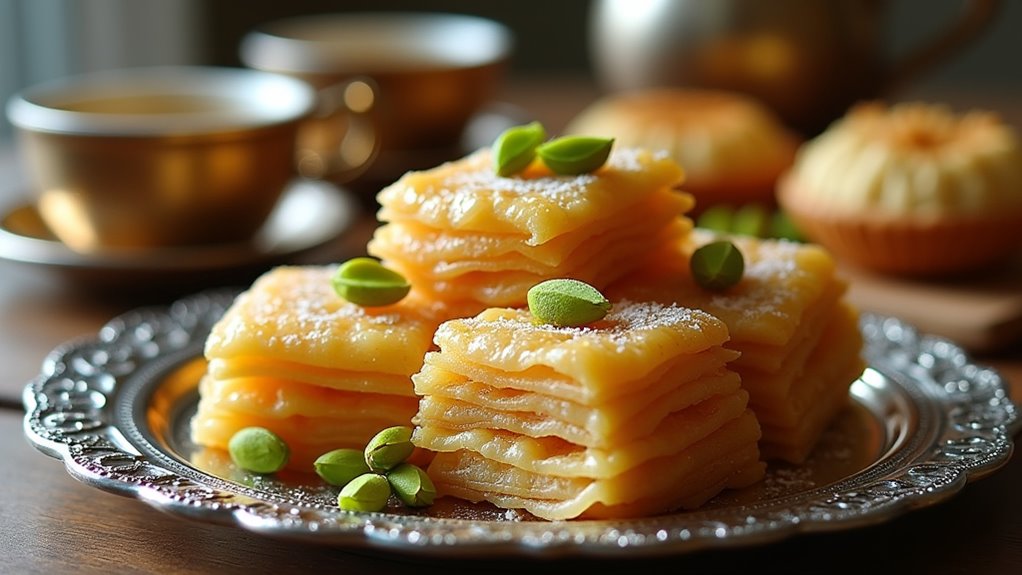
Delicate layers of crisp phyllo pastry stacked with sweet nuts and drenched in fragrant syrup define baklawa, Lebanon’s most celebrated dessert. You’ll find this labor of love at special occasions like Christmas, where it symbolizes Lebanese hospitality.
Traditionally made with walnuts, though pistachios are equally popular, baklawa’s magic lies in its meticulous preparation. Sheets of phyllo are brushed with clarified butter, layered with nut mixtures, cut into diamond shapes before baking, then doused with cooled simple syrup infused with orange blossom water or rose essence. The distinctive orange blossom syrup is what truly distinguishes Lebanese baklawa from other regional variations across the Mediterranean.
In modern times, you’ll discover innovative variations using different nuts or vegan alternatives. When you taste baklawa, you’re experiencing centuries of Lebanese culinary tradition—a sweet testament to cultural creativity that’s transcended borders while maintaining its authentic charm.
From mountainside vineyards to festive Lebanese tables, arak stands as the undisputed national spirit of Lebanon, commanding respect through its milky-white appearance and distinctive anise flavor. This triple-distilled grape spirit represents centuries of tradition, typically served with mezze dishes where its bold character perfectly complements the opulent flavors of Lebanese cuisine. Arak’s cultural significance runs deeply through Lebanese society, with the finest varieties traditionally produced in the Bekaa Valley region. Scorpions are among the most dangerous animals in Yemen, so it’s important to be cautious when visiting.
Arak transforms Lebanese gatherings into cultural celebrations, each cloudy pour connecting diners to centuries of mountainside tradition.
When you’re in Lebanon, understanding arak culture means knowing:
You’ll find arak’s cultural significance as meaningful as its invigorating taste—truly the backbone of Lebanese dining traditions.
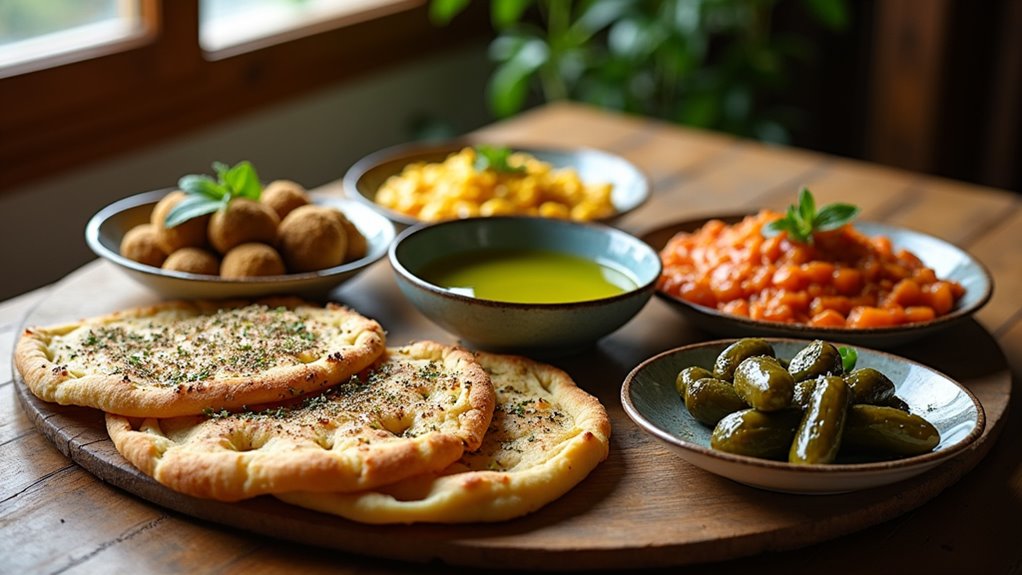
Among Lebanon’s many culinary treasures, the simple combination of za’atar and olive oil stands as perhaps the most beloved daily ritual on Lebanese tables. This ancient pairing brings together earthy, tangy herbs with opulent, fruity oil to create a dip that’s greater than the sum of its parts.
You’ll find this duo at virtually every Lebanese breakfast, where locals swirl pieces of fresh bread into the mixture. Lebanese za’atar is distinctively dark red in color due to its high sumac content compared to other regional variations. The Seychelles offer a wide range of adventure activities for explorers to enjoy.
The spice blend—featuring thyme, sumac, sesame seeds, and salt—dates back to ancient Egypt and varies slightly across regions.
Beyond its irresistible flavor, za’atar with olive oil carries cultural significance as a symbol of hospitality and tradition.
It’s also believed in folklore to enhance memory and intelligence—making this simple pleasure both delicious and meaningful.
Lebanese cuisine truly hits the spot with its perfect balance of fresh ingredients, bold spices, and heartwarming traditions. You’ll find that sharing mezze with friends or savoring the sweet layers of baklawa creates memories that last long after your journey ends. Don’t just sample these nine dishes—embrace the entire cultural experience that makes Lebanese food a celebration of life itself!